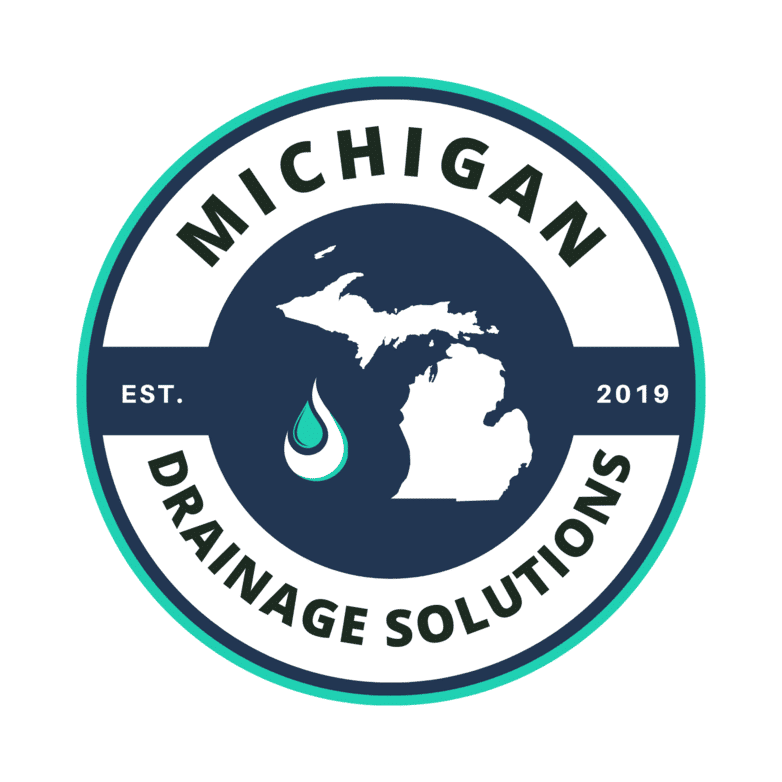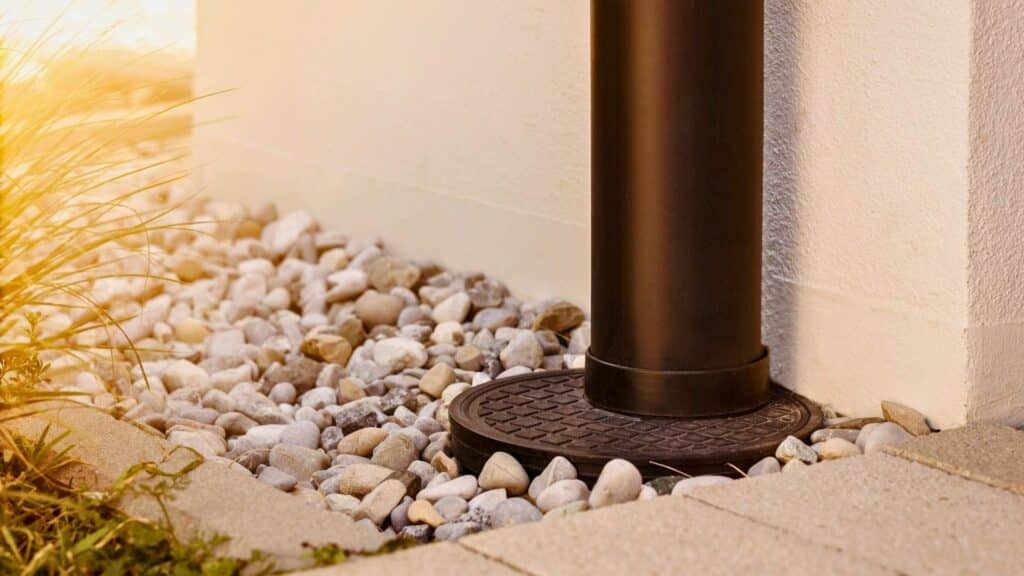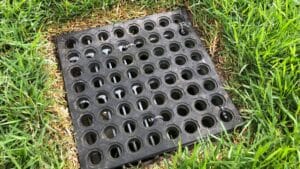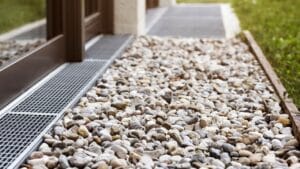When Michigan’s fall rains and winter snowmelt arrive, water can quickly become your home’s biggest enemy. Pooling in your yard, leaking into your basement, or seeping around your foundation — excess water causes costly damage that many homeowners don’t see coming until it’s too late.
Fortunately, there’s a tried-and-true solution that’s been protecting homes for centuries: the French drain. Simple, effective, and long-lasting, French drain installation in Michigan is one of the best ways to redirect water away from your home and prevent flooding, erosion, and foundation problems.
In this comprehensive guide, we’ll explain exactly what a French drain is, how it works, why it’s so effective for Michigan homes, and why professional installation matters.
1. What Is a French Drain?
A French drain is a trench filled with gravel or rock that contains a perforated pipe designed to redirect water away from an area. It’s one of the most efficient ways to manage surface and groundwater around your property.
The concept is simple: water naturally flows downhill through the path of least resistance. The French drain installation in Michigan process takes advantage of that principle by creating an underground channel that captures excess water and guides it safely away from your foundation, yard, or driveway.
Despite its name, the French drain isn’t from France. It was popularized in the mid-1800s by Henry Flagg French, a Massachusetts farmer who developed the system to prevent crop and field flooding — and the name stuck.
2. How a French Drain Works
At its core, French drain installation in Michigan involves three main components:
- A trench dug at a slight downward slope.
- A perforated pipe that collects and transports water.
- Gravel or rock to facilitate drainage and prevent clogging.
Here’s how the system functions:
- When it rains or snow melts, water seeps into the gravel-filled trench.
- The perforated pipe collects this water and directs it toward a safe drainage point — usually a storm drain, dry well, or lower section of the yard.
- As gravity pulls the water through the pipe, your yard, foundation, or basement stays dry.
Proper French drain installation in Michigan ensures that the trench is pitched at the correct slope (typically 1 inch per 8 feet) to allow continuous water flow away from your property.
3. Why Michigan Homes Need French Drains
Michigan’s unique climate and soil conditions make French drains particularly beneficial. Between heavy rainfall, melting snow, and clay-rich soil that doesn’t drain easily, standing water can quickly become a recurring problem.
Here are the top reasons every homeowner should consider French drain installation in Michigan:
a. Prevents Basement Flooding
Basements are especially vulnerable to water intrusion, especially in older Michigan homes. A French drain installed around the perimeter of your foundation captures groundwater before it reaches your basement walls, preventing leaks and structural damage.
b. Protects Your Foundation
Water pooling near your home’s base can lead to cracks, erosion, and hydrostatic pressure buildup — all of which weaken your foundation. A properly installed French drain directs water safely away, maintaining the integrity of your foundation.
c. Eliminates Standing Water in Yards
Soggy lawns aren’t just unsightly — they can kill grass, attract mosquitoes, and create unsafe, muddy areas. With French drain installation in Michigan, your yard stays dry and usable even after heavy storms.
d. Prevents Soil Erosion
Michigan’s sloped properties and freeze-thaw cycles often lead to soil displacement. A French drain stabilizes your landscape by controlling water flow and minimizing erosion.
e. Reduces Frost Heave Risks
When moisture trapped in soil freezes, it expands and can push up against your home’s foundation or driveway. By draining water efficiently, a French drain reduces frost heave and its damaging effects.
4. The Key Benefits of French Drain Installation in Michigan
Choosing French drain installation in Michigan offers long-term peace of mind and several additional benefits:
✅ Long-Lasting Protection
A properly installed French drain can last for decades with minimal maintenance.
✅ Low Maintenance
Unlike above-ground drainage solutions, French drains require very little upkeep once installed.
✅ Versatile Applications
They can be installed around foundations, behind retaining walls, under driveways, or throughout your yard.
✅ Cost-Effective Solution
Compared to repeated landscaping repairs or foundation restoration, a French drain is a smart investment that prevents costly future damage.
✅ Eco-Friendly Option
French drains use gravity and natural materials to move water — no pumps, electricity, or complex machinery required.
Pro Tip: According to The Spruce, French drains are one of the most efficient and eco-friendly drainage systems available for homeowners dealing with persistent moisture problems.
5. Common Problems Caused by Poor Drainage
If you’re unsure whether you need French drain installation in Michigan, it’s helpful to recognize the warning signs of poor drainage.
a. Standing Water After Rain
If puddles linger in your yard for hours or days after rainfall, your property likely has a drainage issue.
b. Basement or Crawlspace Moisture
Damp walls, musty odors, or visible water in your basement are clear indicators of groundwater intrusion.
c. Cracks in Foundation Walls or Floors
Water pressure around your home’s base can cause cracks to form — a serious issue that can compromise structural integrity.
d. Mold and Mildew Growth
Persistent moisture leads to mold, which poses health risks and damages materials like drywall and insulation.
e. Erosion or Uneven Ground
When water isn’t directed properly, it can wash away topsoil, damage landscaping, and create sinkholes over time.
If you notice any of these issues, French drain installation in Michigan could be the long-term solution your home needs.
6. Types of French Drains Used in Michigan
Not all French drains are the same. Depending on your property’s layout and drainage challenges, professionals may recommend one of the following systems:
1. Exterior French Drain (Yard or Perimeter Drain)
Installed around the foundation or low areas of your yard, this type collects and redirects surface and subsurface water away from the home.
2. Interior French Drain (Basement System)
An interior French drain is installed beneath the basement floor. It captures groundwater before it seeps in and directs it to a sump pump system.
3. Curtain Drain
A shallow trench that captures surface water — great for lawns, gardens, and driveways.
4. Deep French Drain
Used for serious flooding or properties with high water tables, these systems reach deeper soil levels to handle large volumes of groundwater.
5. Combination Systems
In some cases, both interior and exterior French drains are installed to provide maximum protection against Michigan’s heavy precipitation.
Professional assessment ensures the correct type of French drain installation in Michigan for your unique property and drainage issues.
7. The French Drain Installation Process
Installing a French drain correctly requires expertise, proper tools, and an understanding of Michigan’s soil composition. Here’s how the process typically works:
Step 1: Site Evaluation and Planning
Experts inspect your property to determine where water collects and how best to redirect it. The trench’s slope, depth, and outlet location are carefully planned.
Step 2: Excavation
A trench (usually 6–12 inches wide and up to 2 feet deep) is dug along the problem area or foundation perimeter.
Step 3: Lining and Pipe Installation
A filter fabric is placed in the trench to prevent soil from clogging the pipe. A perforated PVC or corrugated pipe is then laid in place, sloping downward toward the drainage outlet.
Step 4: Gravel Filling
The trench is filled with clean gravel, which allows water to flow freely into the pipe while filtering out debris.
Step 5: Cover and Finish
The system is covered with more fabric and topsoil, or decorative stones if the drain is part of your landscaping design.
A professional French drain installation in Michigan ensures proper grading, depth, and outlet placement for long-term efficiency.
8. Why DIY Isn’t the Best Option
While installing a French drain might look straightforward, small mistakes can cause big problems — especially in Michigan’s unpredictable weather.
Common DIY Issues Include:
- Incorrect trench slope, leading to standing water inside the pipe.
- Poor material choice (using sand or dirt instead of gravel).
- Improper outlet placement that causes backflow or erosion.
- Clogged systems from lack of filter fabric.
Hiring professionals experienced in French drain installation in Michigan guarantees proper drainage design tailored to your soil, slope, and weather conditions.
9. Maintenance Tips for Your French Drain
A well-installed French drain requires minimal upkeep, but occasional maintenance ensures longevity.
✅ Keep Inlets Clear
Remove leaves, dirt, and debris from entry points to keep water flowing freely.
✅ Inspect Annually
Check for signs of clogs, erosion, or poor drainage — especially after heavy rainfall or snowmelt.
✅ Hydro Jetting
Professional hydro jetting can clear stubborn blockages in the drainpipe, restoring full function without excavation.
✅ Camera Inspections
Periodic camera inspections can identify underground problems early before they lead to bigger issues.
By maintaining your system, your French drain installation in Michigan can protect your home for decades.
10. Why Choose Professional French Drain Installation in Michigan
Michigan’s variable weather and heavy clay soils make professional expertise essential. A trusted contractor ensures your system is designed to handle local conditions — from freeze-thaw expansion to high groundwater levels.
Benefits of Hiring Experts:
- Proper grading and slope for maximum efficiency
- Correct pipe depth and placement
- High-quality materials built to withstand Michigan winters
- Integration with existing gutters, sump pumps, or drainage systems
- Warrantied workmanship and peace of mind
When you choose professionals for French drain installation in Michigan, you’re not just solving a short-term problem — you’re investing in your home’s long-term protection and value.
11. Final Thoughts
Water damage is one of the most expensive problems Michigan homeowners face — and it only gets worse if ignored. Installing a French drain is one of the smartest, most reliable ways to prevent those issues before they start.
Whether you’re dealing with yard flooding, a damp basement, or foundation cracks, French drain installation in Michigan offers a long-term, low-maintenance solution that protects your property through every season.
Need Draining?
Don’t wait for water to find its way into your home this winter — take control of your drainage today. The experts at Michigan Drainage Solutions specialize in professional French drain installation in Michigan that keeps your foundation, lawn, and basement dry year-round.
👉 Contact Michigan Drainage Solutions today to schedule your consultation and discover how a custom French drain can save you thousands in water damage repairs.




